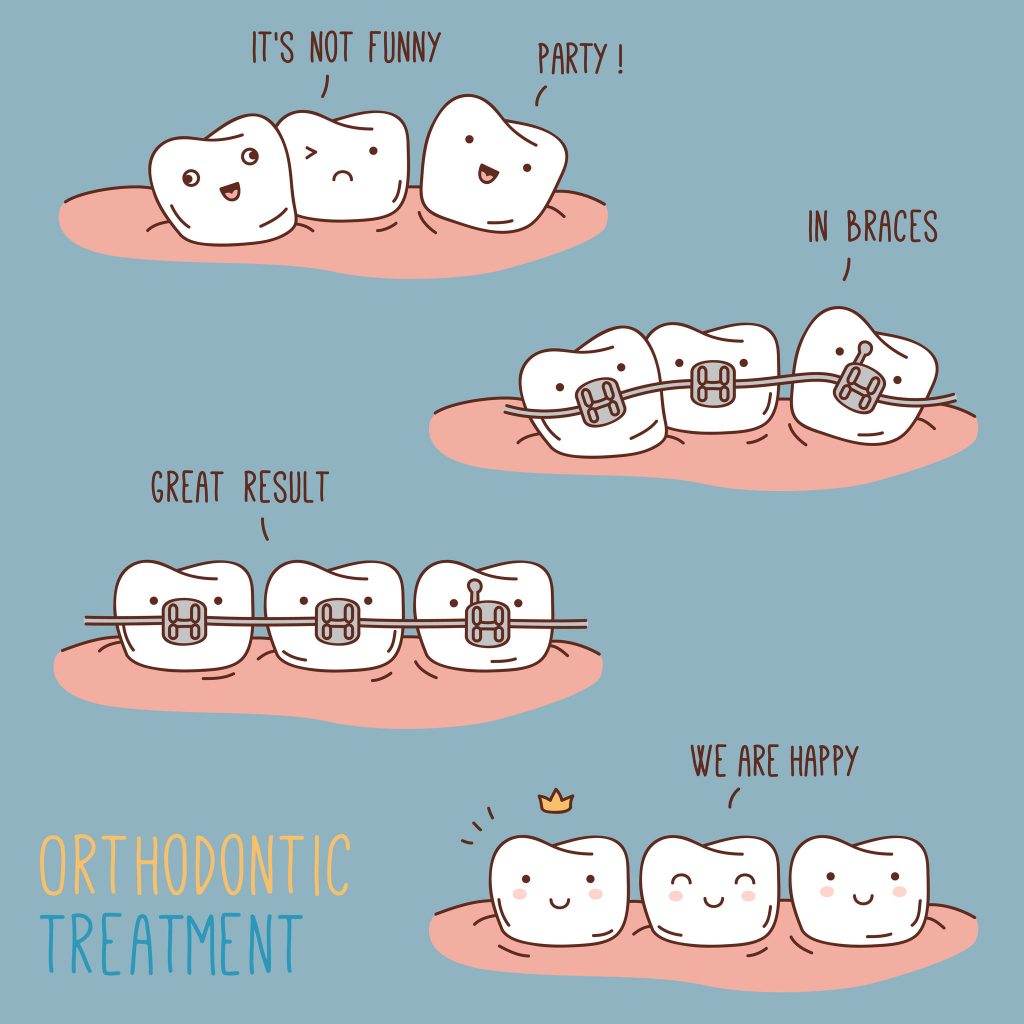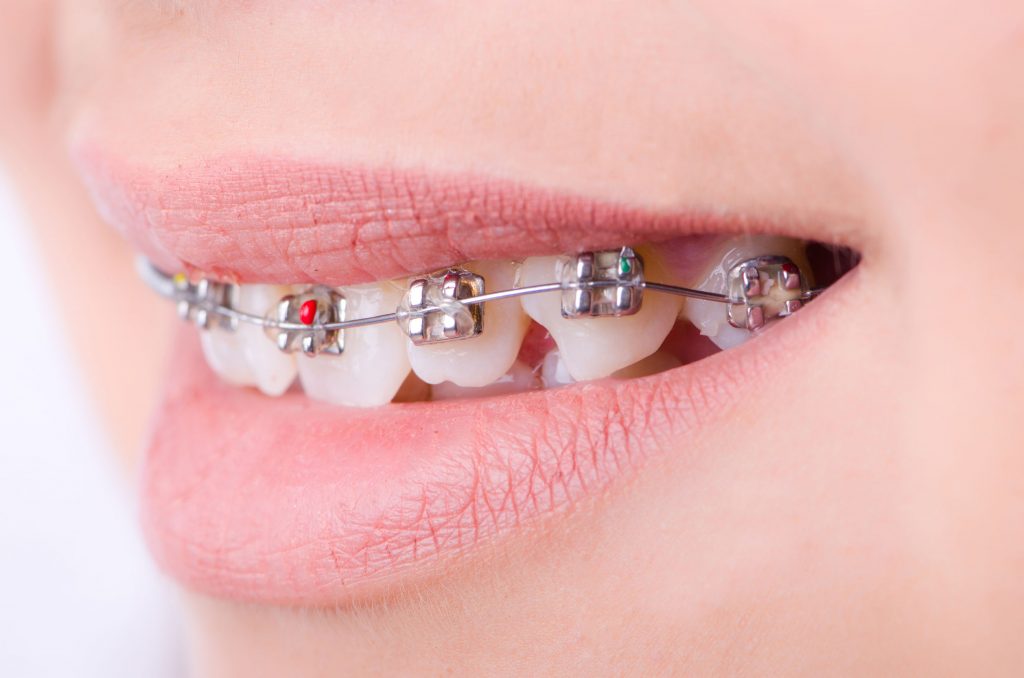Do you smile when someone takes your picture? Do you give a close-lipped, tight smile in hopes that no one will guess your smile isn’t quite as perfect as you’d like it to be? You’re not alone.
Ever since the invention of the camera, people have avoided showing off their pearly whites. The reasons are usually a little different, but they run along the same theme: crooked and gapped teeth. It’s easy to say, “No problem, just get braces!” – but braces aren’t cheap.
That’s how dental insurance can help.
What is Orthodontics?
Orthodontic care isn’t a new idea. For hundreds of years, humans have been practicing dentistry in many forms. To this day, archaeologists are unearthing ancient skulls that have had some rudimentary dental work done. Teeth that have been banded together with metal, shoddy fillings and even false teeth are just some of the discoveries we have made when studying our ancestors.
Curiously, even in prehistoric times, humans were concerned with their bite alignment and crooked teeth and fashioned some very impressive apparatuses out of bones and metal. It wasn’t until the mid-eighteenth century that orthodontics began to get more attention and dentists became more interested in innovating and perfecting their trade.
In place of hastily fashioned inventions, there came the “bandeau” – a horseshoe-shaped metal band which was later innovated by the wire crib. The invention of the elastic band also helped “shape” orthodontics, so to speak.
Thankfully it’s no longer quite such an ordeal to straighten your teeth, nor is it as painful. We now only rely on extracting teeth to make space when all other options have proven ineffective. Orthodontics are consistently being innovated as technology becomes more available.
Do you think you or a family member would benefit from dental braces? Watch these testimonials from the Canadian Association of Orthodontics from people who have.
Why do we need Orthodontics?
Braces aren’t just for correcting crooked teeth. Sure, they are excellent for aligning teeth back into place, but they have more function than that. Cosmetic fixes such as rectifying a diastema (space between teeth) are achieved with orthodontia, as well as spacing out the teeth where they are most crowded.
Orthodontists want to see enough space so you can easily floss and not injure your gums. More severe problems may involve surgical intervention. You may have an over or under bite that requires correction. The aim is to give you full function of your teeth, a matched-up bite, and a beautiful, straight smile.
Orthodontic treatment is most successful with children, as their mouths and jaws are still growing and better able to adapt. Braces can guide the teeth to where they need to be.
New ruptured teeth often need guidance, or else they tend to place themselves wherever there is room. That is not to say, however, that orthodontics is only meant for children, as many full-grown people have also benefitted from braces.
How your Orthodontic treatment works
Before you book your appointment with an orthodontist, you should check your dental insurance to see if orthodontic care is covered. If it isn’t, or if it’s only available to dependent children under the age of 18, as an adult and the plan carrier, you will not be eligible for reimbursement. Your plan may also have a waiting period before you can be reimbursed for orthodontic care.
We may have just the coverage for you, but it’s important to know how that coverage works. The first thing your practitioner will want to do is to hold a consultation to inspect your teeth, assess your bite, take x-rays, and then determine the course of your treatment.
This visit will represent the consultation and diagnostic phase. Once the total cost is calculated for the entire treatment, you will be required to pay an initial fee. Just to be sure, it never hurts to submit a pre-treatment plan to your insurer first.
Over the course of your treatment, your claims will mostly consist of monthly payments. Always be sure to submit your request to your dental insurance company with a standard dental claim form that bears your signature, a comprehensive breakdown of the costs, the date of service, the name of the orthodontist, and his or her contact information.
You must also include your policy number and any other pertinent details.

Always ensure that your dental office has your correct, up-to-date information, as they will need this if they submit a claim on your behalf.
Co-payment percentage
Most plans will pay 50% up to a lifetime maximum. Once that lifetime maximum is reached, you will no longer be eligible for any claims of an orthodontic nature. Even if it’s a very costly treatment, the percentages still apply.
Let’s say that your orthodontic plan pays a lifetime maximum of $2,000.00 at 50%. Your total treatment plan costs you $6,000 and the initial fee is $2,100.00. You would be reimbursed $2,000, and no further claims would be eligible.
Remember that this maximum is per person. Your maximum will not affect another family member.
Your initial fee – be careful!
Your entire treatment plan will likely be several thousand dollars in total, depending on the state of your mouth, of course. When your orthodontist creates your timeline, he or she will ask that you pay a lump sum in advance for the initial fee. This fee is eligible for reimbursement, but your orthodontist must ensure that it does not exceed 35% of the total amount.
For example, if the total cost of your treatment is estimated to be $3,500, you should not be billed more than $1,225 for the initial fee. If the amount exceeds 35%, your insurance provider may cut the claim back accordingly.
Monthly treatment fees
Every month you will need adjustments to your braces — the bands will need to be tightened or replaced. Your orthodontist will perform the treatment and should send a claim to your insurance company for the visit.
These appointments are broken down into a fixed rate every month for however many months the orthodontists deem necessary for your treatment. For example, your practitioner wants you to come in once a month for 24 months. Each visit costs $120. You can claim the $120 every month until your maximum is reached unless there is a co-payment.
Reimbursing the entire treatment
In an effort to keep the costs down, some orthodontists are kind enough to give a lower rate if you pay the whole treatment in full, and in advance. This is a very nice thing for them to do, but it will create problems with your claim if you try to get reimbursed for the entire amount.
Your insurance provider will only pay for treatment that has already been rendered. They cannot pay for services that have not yet taken place.
Even if you submit an estimate with a treatment plan, your insurance company can only pay for what has already been done. If you have already paid the entire amount, your plan will pay the eligible 35% for the initial fee, any diagnostic fees, and will pay your monthly fees as they pass. You will be paid your entitlements but slowly over time.
Other types of braces
Technology has improved over the past few years; you have more choices available to you. There are the standard braces with the metal components, or you can opt to have ceramic tooth-coloured brackets, which are more costly. Some plans may allow Invisalign invisible braces that you can remove when you eat, but they are a more expensive option. Your plan may expressly state what types of braces it will cover, but when in doubt, send an estimate.

Your treatment doesn’t end when your braces come off. You may have some retention costs that will be eligible, provided you still have some of your maximum benefit left over. You may need to wear a retainer for a few months or at night.
Ready for Orthodontic care?
Orthodontic care is expensive no matter how you look at it, but dental insurance helps you to take steps to have that smile you want. Dental insurance can reduce your out-of-pocket costs for routine and unexpected dental care, plus provide the peace of mind that comes from having the financial protection of insurance. With dental insurance, you have better access to the preventative care you need to keep your teeth healthy and beautiful. The better you take care of your teeth, the lower your overall costs for dental care will be.
SBIS makes it easy to obtain affordable dental insurance, which is important given the increasing cost of dental care. Our dental plans offer Basic Coverage, Comprehensive Basic, and Major Services coverage for special care like orthodontics.
Anyone can apply for any level of dental benefit they need! And individuals coming off a group plan may apply for special plans designed just for them. Check out your options today or give us a call at 1-800-667-0429 to get dental insurance coverage that will make you smile.




